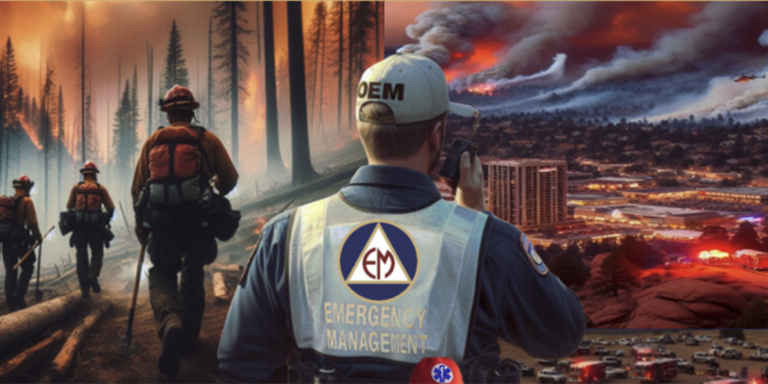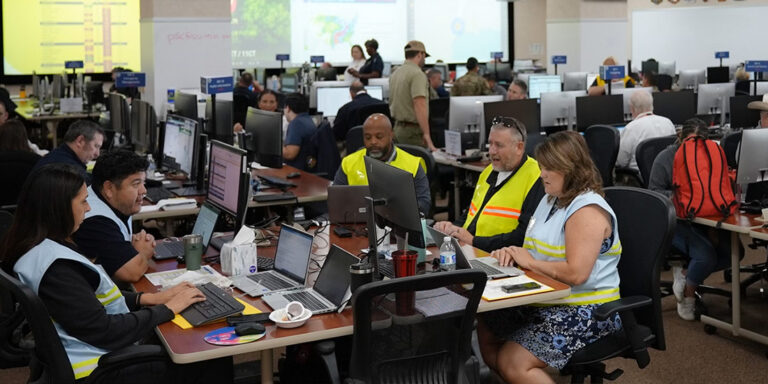
Article Archive by Year

From historic catastrophes to today’s challenges, crises pose significant public threats. By returning to the basics and prioritizing deliberate preparation, organizational leaders can build greater resilience, enhance performance, and lead effectively when it matters most.

Imagining the U.S. Without Power: A Dual-World EMP Exercise
February 12, 2025
A dual-world tabletop exercise simulating an electromagnetic pulse event in Chicopee, Massachusetts, revealed startling discrepancies in outcomes between the city’s current preparedness and a moderate-preparedness simulation.

The Forefront of Innovation in Training & Exercises: Disaster Gaming
February 12, 2025
Disaster wargaming may significantly change the future of tabletop exercises in emergency management and homeland security. Long used effectively to win and prevent wars throughout history, wargaming offers more realistic and engaging scenarios for emergency managers to prepare for real-world disasters.

U.S. Withdrawal from the World Health Organization: Emergency Preparedness Implications
February 12, 2025
As the U.S. contemplates withdrawing its membership from the World Health Organization, there are potential impacts on both local and global emergency preparedness and response to consider. Emergency managers should evaluate their current programs to determine ramifications in their local sectors.

The Vulnerability of Public Figures: Lessons from UnitedHealthcare
February 5, 2025
High-profile business leaders like UnitedHealthcare’s murdered CEO have been at an elevated risk of targeted violence in the past several years. Although such attacks on corporate executives and other public figures are rare, they are targeted. In response, many corporations have increased personal protection for executives, but the permanence of

Keeping Humans in the Loop: The Future of Emergency Management
February 5, 2025
The emergence of powerful artificial intelligence tools generates excitement and apprehension, raising profound questions about the future of emergency response. By adopting the joint cognitive systems paradigm, emergency managers are offered a new way of thinking about their work in this environment.

Overcoming Communications Challenges: A Hurricane Helene Success
January 29, 2025
As part of the Texas Division of Emergency Management’s Hurricane Helene Incident Support Task Force, Emergency Management Coordinator Jarod Rosson experienced firsthand what it is like to respond to a disaster when all ground-based forms of communication are offline.

Editor’s Note: Responding to Disasters in 2025 and Beyond
January 29, 2025
The December 2024 edition of the Domestic Preparedness Journal provides insight into the intersection of AI and emergency preparedness. With their exponentially increasing speed of development, existing, emerging, and not-yet-created technologies must all be part of the planning process in 2025 and beyond.

All at Once: Multi-Incident Simultaneous Response and Recovery
January 29, 2025
As demonstrated by hurricanes Helene and Milton, jurisdictions unaccustomed to compounding incidents can bolster their readiness to simultaneously respond and recover by proactively examining and preparing for unique challenges posed by such a scenario.

Nonmedical Concerns for Hospitals in a Mass-Casualty Incident
January 22, 2025
Nonmedical concerns such as security and safety, unaccompanied minors, and governmental relations can adversely impact a hospital when responding to a mass-casualty incident. Failure to plan for these issues, including consequence management, could risk life and safety.
Back to the Basics: Navigating Crisis Leadership
February 19, 2025
From historic catastrophes to today’s challenges, crises pose significant public threats. By returning to the basics and prioritizing deliberate preparation, organizational leaders can build greater resilience, enhance performance, and lead effectively when it matters most.
Imagining the U.S. Without Power: A Dual-World EMP Exercise
February 12, 2025
A dual-world tabletop exercise simulating an electromagnetic pulse event in Chicopee, Massachusetts, revealed startling discrepancies in outcomes between the city’s current preparedness and a moderate-preparedness simulation.
The Forefront of Innovation in Training & Exercises: Disaster Gaming
February 12, 2025
Disaster wargaming may significantly change the future of tabletop exercises in emergency management and homeland security. Long used effectively to win and prevent wars throughout history, wargaming offers more realistic and engaging scenarios for emergency managers to prepare for real-world disasters.
U.S. Withdrawal from the World Health Organization: Emergency Preparedness Implications
February 12, 2025
As the U.S. contemplates withdrawing its membership from the World Health Organization, there are potential impacts on both local and global emergency preparedness and response to consider. Emergency managers should evaluate their current programs to determine ramifications in their local sectors.
The Vulnerability of Public Figures: Lessons from UnitedHealthcare
February 5, 2025
High-profile business leaders like UnitedHealthcare’s murdered CEO have been at an elevated risk of targeted violence in the past several years. Although such attacks on corporate executives and other public figures are rare, they are targeted. In response, many corporations have increased personal protection for executives, but the permanence of
Keeping Humans in the Loop: The Future of Emergency Management
February 5, 2025
The emergence of powerful artificial intelligence tools generates excitement and apprehension, raising profound questions about the future of emergency response. By adopting the joint cognitive systems paradigm, emergency managers are offered a new way of thinking about their work in this environment.
Overcoming Communications Challenges: A Hurricane Helene Success
January 29, 2025
As part of the Texas Division of Emergency Management’s Hurricane Helene Incident Support Task Force, Emergency Management Coordinator Jarod Rosson experienced firsthand what it is like to respond to a disaster when all ground-based forms of communication are offline.
Editor’s Note: Responding to Disasters in 2025 and Beyond
January 29, 2025
The December 2024 edition of the Domestic Preparedness Journal provides insight into the intersection of AI and emergency preparedness. With their exponentially increasing speed of development, existing, emerging, and not-yet-created technologies must all be part of the planning process in 2025 and beyond.
All at Once: Multi-Incident Simultaneous Response and Recovery
January 29, 2025
As demonstrated by hurricanes Helene and Milton, jurisdictions unaccustomed to compounding incidents can bolster their readiness to simultaneously respond and recover by proactively examining and preparing for unique challenges posed by such a scenario.
Nonmedical Concerns for Hospitals in a Mass-Casualty Incident
January 22, 2025
Nonmedical concerns such as security and safety, unaccompanied minors, and governmental relations can adversely impact a hospital when responding to a mass-casualty incident. Failure to plan for these issues, including consequence management, could risk life and safety.
Follow Us
Get Instant Access
Subscribe today to Domestic Preparedness and get real-world insights for safer communities.
ARchives
Article Out Loud – Preparing for the Next Biothreat: Lessons Not to Forget
January 15, 2025
In 2024, senior officials from hospitals, healthcare organizations, public health, emergency management, and other responder communities convened at two workshops to share the lessons they learned as leaders during the COVID-19 pandemic. Learn more about how communities can better prepare for the next biothreat.
Article Out Loud – Mission Ready Packages: New Possibilities
January 15, 2025
In 2005, the Superdome in New Orleans served as a mass shelter and accommodated over 25,000 people during Hurricane Katrina. Those accommodations, though, were inadequate, with limited power, plumbing, and other resources. To avoid a similar scenario, the Mission Ready Venue Initiative enables stadiums to be a resource for immediate
Article Out Loud – Evolution of a Critical Emergency Response Tool
January 8, 2025
During a derecho in May 2024, Texas agencies contacted and conducted wellness checks on residents with disabilities or with functional and access needs. One tool facilitated the process, sharing critical information about registrants to the emergency responders and planners who needed to know. Learn about this collaborative process.
Article Out Loud – Why Public Works Needs a Seat at the Planning Table
January 8, 2025
This is an article by Greg Hoffnung, an Article Out Loud from Domestic Preparedness, January 8, 2025. Despite their critical role in disaster response, public works agencies are not always included in the emergency planning process. Key steps can help ensure that these and other agencies can more effectively respond
Article Out Loud – A Data-Driven Approach to Police Recruitment and Retention
December 26, 2024
AI’s ability to ingest and synthesize data on hazards and vulnerabilities could prove invaluable in addressing one of the biggest long-standing challenges of emergency management: truly engaging the whole community.
Article Out Loud – The Role of AI in Meeting a Great Emergency Management Challenge
December 26, 2024
AI’s ability to ingest and synthesize data on hazards and vulnerabilities could prove invaluable in addressing one of the biggest long-standing challenges of emergency management: truly engaging the whole community.
Article Out Loud – Opportunities for Artificial Intelligence in Emergency Management
December 18, 2024
This is an article by Alex Hagen and Jon Barr, an Article Out Loud from Domestic Preparedness, December 18, 2024. Recent research into the relationship between AI and emergency management uncovered an environment prepared for AI-based solutions. While AI must overcome some infrastructure hurdles, technologies to prevent, mitigate, and recover
ARTICLE OUT LOUD – Introducing AI to the Emergency Management Workforce: A Case Study
December 18, 2024
This is an article by Lenora G. Borchardt, an Article Out Loud from Domestic Preparedness, December 18, 2024. AI can contribute to professional competency and learners’ success while efficiently training emergency management professionals and managing the bottom line. Learn how AI can create competency and outcomes-based learning tailored to each
ARTICLE OUT LOUD – From Today to Tomorrow: The Emergency Operations Center of the Future
December 11, 2024
This is an article by Nick Betzsold and Grant Tietje, an Article Out Loud from Domestic Preparedness, December 11, 2024. The next-generation EOC, which implements cutting-edge technology and AI, does not promise perfect disaster management, but it does mean responders at all levels will have better situational awareness, plan more
Article Out Loud – Emergency Management of Tomorrow: Emerging Technologies and Concepts
December 11, 2024
Electricity substations are traditionally only protected by chain-link fences and signage warning of the dangers of high voltage. However, this still leaves property vulnerable, especially to weaponized drones attacking from above, a mode of terrorism being used more extensively across the world and at home. Learn about the vulnerability of
Follow Us
Get Instant Access
Subscribe today to Domestic Preparedness and get real-world insights for safer communities.


